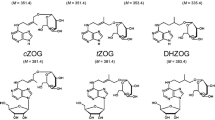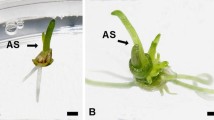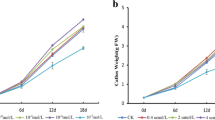Abstract
Cotyledons ofPhaseolus vulgaris L. contain small amounts of phaseollin and kievitone. Isolating the cotyledons from the plant does not alter phaseollin levels. Kievitone levels, however, although not affected in light-incubated cotyledons, increased rapidly in dark-incubated cotyledons. Abscisic acid (ABA) at 10-4 M stimulated the accumulation of phaseollin in excised cotyledons in both light and darkness, whereas benzylaminopurine (BAP) increased these levels only in the light. The kievitone level was influenced by ABA and BAP only in dark-incubated cotyledons, i.e., inhibited at 10-4 M. When excised cotyledons were treated with mercuric chloride, both phaseollin and kievitone accumulated rapidly in both light and darkness. The effect of ABA on these cotyledons was similar to that on non-treated cotyledons. The results demonstrate that the synthesis of the two phytoalexins is regulated by separate mechanisms and indicate that the phytoalexin composition is dependent on the physiological condition of the cotyledons. ABA and BAP may play a role in the resistance response of the plant.
Similar content being viewed by others
Abbreviations
- ABA:
-
abscisic acid
- BAP:
-
benzylaminopurine
References
Bailey, J.A. (1969) Phytoalexin production by leaves ofPisum sativum in relation to senescence. Ann. Appl. Biol.64, 315–324
Bailey, J.A., Berthier, M. (1981) Phytoalexin accumulation in chloroform-treated cotyledons ofPhaseolus vulgaris. Phytochemistry20, 187–188
Barz, W., Adamek, Ch. (1970) Über den Einfluß von Licht auf den Umsatz der Isoflavone Formononetin and Biochanin A inCicer arietinum L. Planta90, 191–202
Barz, W., Hösel, W., Adamek, Ch. (1971) Über den Einfluß von Licht auf den Umsatz von Flavonolen und Isoflavonen inCicer arietinum L. Phytochemistry10, 343–349
Cruickshank, I.A.M., Perrin, D.R. (1963) Phytoalexins of the Leguminosae. Phaseollin fromPhaseolus vulgaris L. Life Sci.9, 680–682
Cruickshank, I.A.M., Perrin, D.R. (1971) Studies on phytoalexins. XI. The induction, antimicrobial spectrum and chemical assay of phaseollin. Phytopathol. Z.70, 209–229
Deverall, B.J. (1976) Current perspectives in research on phytoalexins. In: Biochemical aspects of plant-parasite relationships. pp. 208–222, Friend, J., Threlfall, D.R., eds. Academic Press, London New York San Francisco
Dixon, R.A., Bendall, D.S. (1978) Changes in the levels of enzymes of phenylpropanoid and flavonoid synthesis during phaseollin production in cell suspension cultures ofPhaseolus vulgaris. Physiol. Plant Pathol.13, 295–306
Dixon, R.A., Dey, P.M., Murphy, D.L., Whitehead, I.M. (1981) Dose responses forColletotrichum lindemuthianum elicitor-mediated enzyme induction in French bean cell suspension cultures. Planta151, 272–280
Dixon, R.A., Fuller, K.W. (1976) Effects of synthetic auxin levels on phaseollin production and phenylalanine-ammonia-lyase (PAL) activity in tissue cultures ofPhaseolus vulgaris L. Physiol. Plant Pathol.9, 299–312
Dixon, R.A., Fuller, K.W. (1978) Effects of growth substances on non-induced andBotrytis cinerea culture filtrate-induced phaseollin production inPhaseolus vulgaris cell suspension cultures. Physiol. Plant Pathol.12, 279–288
Gustine, D.L., Sherwood, R.T., Vance, C.P. (1978) Regulation of phytoalexin synthesis in jackbean callus cultures. Plant Physiol.61, 226–230
Hahlbrock, K., Lamb, C.J., Purwin, C., Ebel, J., Fautz, E., Schäfer, E. (1981) Rapid response of suspension-cultured parsley cells to the elicitor fromPhytophthora megasperma var. sojae. Plant Physiol.67, 768–773
Hargreaves, J.A. (1979) Investigations into the mechanism of mercuric chloride stimulated phytoalexin accumulation inPhaseolus vulgaris andPisum sativum. Physiol. Plant Pathol.15, 279–287
Hargreaves, J.A. (1981) Accumulation of phytoalexins in cotyledons of French bean (Phaseolus vulgaris L.) following treatment with triton (T-octylphenolpolyethoxyethanol) surfactants. New Phytol.87, 733–741
Hargreaves, J.A., Bailey, J.A. (1978) Phytoalexin production by hypocotyls ofPhaseolus vulgaris in response to constitutive metabolites released by damaged bean cells. Physiol. Plant Pathol.13, 89–100
Hargreaves, J.A., Selby, C. (1978) Phytoalexin formation in cell suspensions ofPhaseolus vulgaris in response to an extract of bean hypocotyls. Phytochemistry17, 1099–1102
Paradies, I., Elstner, E.F. (1980) Wirt-Parasit-Beziehungen: Untersuchungen zur Induktion der Äthylenbildung in höheren Pflanzen und zur Rolle des Äthylens bei der Ausprägung von Krankheitssymptomen und der Einleitung von Abwehrreaktionen. Ber. Dtsch. Bot. Ges.93, 635–657
Paradies, I., Hämme, B., Hoppe, H.H., Heitefuss, R., Elstner, E.F. (1979) Induction of ethylene formation in bean (Phaseolus vulgaris) hypocotyl segments by preparations isolated from germ tube cell walls ofUromyces phaseoli. Planta146, 193–197
Perrin, D.R. (1964) The structure of phaseollin. Tetrahedron Lett.1, 29–35
Smith, B.G., Rubery, P.H. (1981) The effects of infection by Phytophthora infestans on the control of phenylpropanoid metabolism in wounded potato tissue. Planta151, 535–540
Smith, D.A., Van Etten, H.D., Serum, J.W., Jones, T.M., Bateman, D.F., Williams, T.H., Coffen, D.L. (1973) Comirmation of the structure of kievitone, an antifungal isoflavanone isolated fromRhizoctonia-infected bean tissues. Physiol. Plant Pathol.3, 293–297
Tillberg, E. (1974) Levels of indol-3yl-acetic acid and acid inhibitors in green and etiolated bean seedlings (Phaseolus vulgaris). Physiol. Plant.31, 106–111
Van Etten, H.D., Pueppke, S.G. (1976) Isoflavonoid phytoalexins. In: Biochemical aspects of plant-parasite relationships, pp. 239–289, Friend, J., Threlfall, D.R., eds. Academic Press, London New York San Francisco
Whenham, R.J., Fraser, R.S.S. (1980) Stimulation of RNA synthesis in discs from healthy and tobacco mosaic virus-infected tobacco leaves. Planta150, 349–353
Whenham, R.J., Fraser, R.S.S. (1980) Effect of systemic and locallesion-forming strains of tobacco mosaic virus on abscisic acid concentration in toabcco leaves: consequences for the control of leaf growth. Physiol. Plant Pathol.18, 267–278
Author information
Authors and Affiliations
Rights and permissions
About this article
Cite this article
Goossens, J.F.V., Vendrig, J.C. Effects of abscisic acid, cytokinins, and light on isoflavonoid phytoalexin accumulation inPhaseolus vulgaris L.. Planta 154, 441–446 (1982). https://doi.org/10.1007/BF01267811
Received:
Accepted:
Issue Date:
DOI: https://doi.org/10.1007/BF01267811




